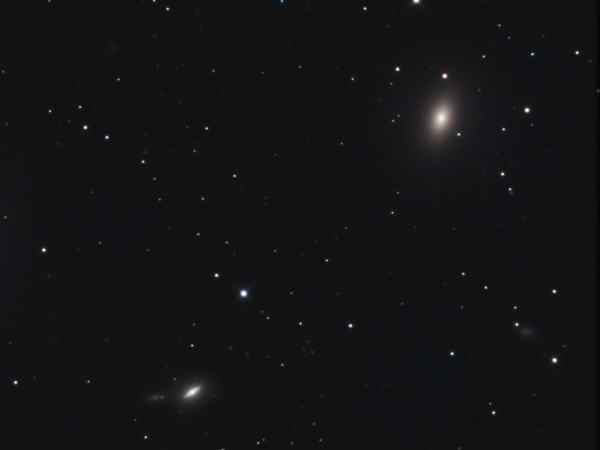Observations of M60
These are the observations available for M60. If you have any of your own that you'd like to submit we'd love to put them on the website.
-
Messier 59 and Messier 60 in Virgo
The galaxies of the Virgo cluster in Messier's catalogue are among the outstanding Messier objects on my Messier imaging marathon. I have found these galaxies to be challenging objects to observe. The spring weather is usually contrary and the rapidly brightening evening skies give little time for imaging. I was very pleased, therefore, to image both M59 and M60 in the field of view of my 8-inch RC.

This image of the galaxies Messier 59 and Messier 60 was provided by David Davies and taken from Cambridge in the UK. To see more of David's work please visit his Flickr Photostream. Click on the image for the larger version. I have found this image to be fascinating to examine as it contains many faint galaxies including the compact dwarf galaxies associated with M59 and M60. I've included an inverted version of the image for lovers of faint fuzzies. On this image, I've discovered galaxies fainter than magnitude 19, including the dwarf galaxies M60UCD1 and M59UDC3.

This inverted image of the Messier 59 and Messier 60 was provided by David Davies and taken from Cambridge in the UK. This brings out some of the really faint galaxies in the region. Click on the image for the larger version. I've attached two crops from the main image, showing M59 and M60 separately - and making better compositions.

This image of the Messier 59 was provided by David Davies and taken from Cambridge in the UK. 
This image of Messier 60 and Arp 116 was provided by David Davies and taken from Cambridge in the UK. Messiers 59 and 60 in Virgo were discovered by Johann Kohler on 11th April 1799 whilst observing a comet. Messier himself discovered them, independently, days later and noted them in his list. Messier 60 (lower left) is interacting with NGC 4647, discovered by William Herschel and was given the designation of Arp 116 by Harlton Arp.
Image Details
Capturing the image data proved to be quite challenging as there are few bright stars in this part of the sky and my off-axis guide camera had to use a magnitude 12 star as a guide star, needing constant monitoring of the image capture process.
- Telescope: 8" Ritchey-Chretien.
- Camera: QSI 683.
- Mount: Skywatcher EQ8.
The image comprises 20 x five-minutes luminance and 10 x 5-minutes each of RGB, binned 2 x 2.
David Davies - (22 April 2020).